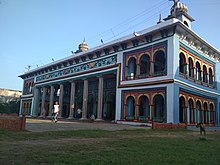| Dumraon Raj | |||||||||
|---|---|---|---|---|---|---|---|---|---|
| 1709–1952 | |||||||||
 Coat of arms
Coat of arms
| |||||||||
| Status |
| ||||||||
| Capital | Dumraon | ||||||||
| Religion | Hinduism (official) | ||||||||
| Government | Fedual Monarchy | ||||||||
| Maharaja | |||||||||
| • 1701 | Raja Horil Singh (first) | ||||||||
| • 1952 | Maharaja Bahadur Ram Ran Vijay Prasad Singh (last) | ||||||||
| Historical era | Medieval India | ||||||||
| • Established | 1709 | ||||||||
| • Disestablished | 1952 | ||||||||
| |||||||||
The Dumraon Raj was a feudal principality in the Bhojpur region ruled by the Ujjainiya dynasty. The principality was founded when Raja Horil Singh founded a separate capital for himself in the town of Dumraon. The name Dumraon Raj came from its capital town.

It was a zamindari state during British era. During the time of Indian independence, Dumraon Raj covered an area of 2,330 km which stretched from Buxar district in west Bihar to Ballia district in the Purvanchal region of Uttar Pradesh. In Ballia district, Dumraon Raj covered rights of more than 70 villages which are located on the banks of the Ganga river.
The royal family of Dumraon is also the main patron of the famous Brahampur fair.
History
The founders of Dumraon Raj were Ujjainiya Rajputs who traced their origin to the Parmar rulers of Malwa who moved to Western Bihar in the 14th century. In the medieval era, the head seat of Ujjainiyas was Bhojpur.
Raja Mukutman Shahi who ascended the throne of Bhojpur in 1601 was highly unpopular amongst his kinsmen and thus he was forced to abdicate in 1607 in favour of his nephew.
In 1607, Raja Narayan Mal came to the throne of Bhojpur and he was recognised as the new ruler of Bhojpur by Mughal Emperor. He received the title of Raja and was granted the rank mansab of 5000. In the Battle of Buxar 1607-1608, he routed the Chero and Munda forces. The Rajas of Bhojpur were known for their rebellious behaviour against Mughal rule and during the family feud of the ruling family of Bhojpur, the Mughal governor found this opportunity to completely sack Bhojpur. The territory of Bhojpur was sacked in the year 1699 and it came under direct Mughal rule.
One of the descendants of Raja Narayan Mal, Raja Horil Singh, established himself separately and built the capital town of Dumraon in 1709. He got recognised to rule his dominion under Mughal rule. This is how Dumraon Raj came into existence. However, the rulers of Dumraon Raj were only recognised as feudal rulers.
Rulers
The rulers of Dumraon Raj used the title Raja and later Maharaja.
- Raja Horil Singh, he separated himself and his principality from its parent house and declared himself as the independent ruler of Dumraon.
- Raja Vikramaditya Singh
- Raja Jai Prakash Singh
- Raja Janki Prasad Singh
- Raja Maheshwar Baksh Singh
- Maharaja Radha Prasad Singh
- Maharani Beni Prasad Kuari
- Maharaja Srinivas Prasad Singh
- Maharaja Keshav Prasad Singh
- Maharaja Ram Ran Vijay Prasad Singh
- Maharaja Kamal Bahadur Singh
See also
References
- Brahmadeva Prasad Ambashthya (1959). "Some Historical Papers of Dumraon Raj in the Shahabad district in Bihar". Proceedings of the Indian History Congress. 22: 270–281. JSTOR 44304307.
- Surendra Gopal (22 December 2017). Mapping Bihar: From Medieval to Modern Times. Taylor & Francis. pp. 293–. ISBN 978-1-351-03416-6.
- O’malley, L. s s (1906). Bengal District Gazetteers Shahabad. p. 139.
- Anand A. Yang (1 February 1999). Bazaar India: Markets, Society, and the Colonial State in Bihar. University of California Press. p. 146. ISBN 978-0-520-91996-9.
- ^ Anand A. Yang (1 February 1999). Bazaar India: Markets, Society, and the Colonial State in Bihar. University of California Press. pp. 139–. ISBN 978-0-520-91996-9.
- ^ Tahir Hussain Ansari (2019). Mughal Administration and the Zamindars of Bihar. ISBN 978-81-87879-54-1.
- Sir Roper Lethbridge (2005). The Golden Book of India: A Genealogical and Biographical Dictionary of the Ruling Princes, Chiefs, Nobles, and Other Personages, Titled Or Decorated of the Indian Empire. Aakar Books. pp. 128–. ISBN 978-81-87879-54-1.
- Kolff, Dirk H. A. (1990). Naukar, Rajput, and Sepoy: The Ethnohistory of the Military Labour Market of Hindustan, 1450-1850. Cambridge University Press. pp. 59–60. ISBN 978-0-52152-305-9.